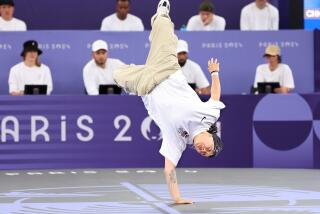They’re Beating the Drum for Female Empowerment
- Share via
When LizAnn Shimamoto was 12, her mother forced her to take an etiquette class, where Shimamoto learned all the things a “good girl” should be, how to be “ladylike” and “mild-mannered” and above all, quiet.
Now, at 39, Shimamoto yells.
She yells while playing the odaiko, a drum roughly the size of a refrigerator. She yells as if she’s sending a message across the Grand Canyon. She yells because it gives her a sense of power, because it’s fun and because it encourages her fellow drummers--including daughters Amy, 14, and Grace, 11--to keep the beat.
Of the 18 performers in Shimamoto’s group, Satori Daiko, 13 are women. It’s a breakdown reflected in Japanese drumming, or taiko, groups across North America: About two-thirds of the roughly 150 taiko groups are composed of women, especially Asian American women. Many of these women have snatched up bachi, or wooden drumming sticks, to rediscover their roots--and to redefine their roles as women.
“What we’re doing is contradictory to what a Japanese female has traditionally been taught to do,” said Shimamoto of Monterey Park. “It’s a mirror of what’s happening culturally.”
Once “extremely meek and shy,” Shimamoto plays taiko with a grin on her face as wide as Julia Roberts’. She moves her feet wide apart. She raises the bachi as if they were nunchuks and pounds the cowhide-covered barrel. She pants. She sweats. And of course, she belts out an occasional kake-goe, or yell, to support her daughters.
Taiko-playing women like Shimamoto are reshaping anachronistic images of the Asian woman as a “femme fatale” or “subservient housewife,” said fellow Satori Daiko member Deborah Wong. “In both cases, Asian women’s bodies are over-eroticized,” said Wong, 42, an ethnomusicologist at UC Riverside and author of an article titled “Taiko and the Asian/American Body: Drums, ‘Rising Sun’ and the Question of Gender.”
“Through performance, we’re able to redefine the status quo ... not by denying the body but by redefining the body in terms of strength and discipline.”
Women taiko players are becoming more visible as Japanese drumming edges into the mainstream, with about 150 performing groups nationwide, said the Rev. Tom Kurai, director of the Montebello-based Taiko Center of Los Angeles, home to Satori Daiko.
Kurai’s group has a jammed schedule that has taken it across America and even to Japan. On Friday, members of Satori Daiko pounded their taikos at home plate in Dodger Stadium, and they will perform again during next weekend’s Summer Japanese Festival in Torrance. The flurry of practices and performances bonds the players. “They’re like family,” Grace said.
But taiko has become a cooperative effort only in the last few decades. Historians believe the taiko, meaning “fat drum,” was first beaten thousands of years ago in Japanese villages to give the time or signal imminent storms. Later, Buddhists also incorporated taiko playing in temples.
In 1951, Daihachi Oguchi, a jazz drummer in Japan, dreamed up a kumi-daiko, or taiko ensemble, but it wasn’t until after Seiichi Tanaka brought the concept to America in 1968 that more women started banging on taikos, Kurai said.
In kumi-daiko, the drums constitute an orchestra of percussion. The rhythm wouldn’t work without the small, high-pitched sumo-daiko acting as a metronome, or the troop of midsized chu-daiko functioning as a tenor instrument. But for crowd appeal, nothing beats the deep boom of the big odaiko.
“It’s incredibly appealing to many women who want to have the social aesthetic of working together as a group,” Wong said.
And seeing women empower themselves through cooperation nudges others to do the same.
“When I was in a band, females didn’t do percussion,” said Harriet Mizuno-Moyer, 50, who plays in Satori Daiko with her 13-year-old daughter, Taylor Moyer. “I saw a taiko group and saw women, and I was like, ‘Wow, these women are playing the drums,’ ” Mizuno-Moyer said.
Men recognize that, by wielding taiko sticks, women are recasting outdated images. “It’s an opportunity to break the rules,” said Antoine Gautier, 26, also in Satori Daiko. “There’s a stigma against women playing loud. Usually it’s men on the drums.”
Younger women also seize on taiko’s significance for gender equity. For Michelle Fujii, 28, of Los Angeles-based On Taiko, it means making sure that men participate in movement-oriented taiko, which incorporates dance steps, and that women do such “male things” as drum solos.
At a practice in Sozenji Buddhist Temple in Montebello, Satori Daiko’s players dish out a flurry of shouts--a vocal improvisation meant to unleash energy and signal camaraderie.
“Ho!” yells Shimamoto over the rumble. “Sa!” respond daughters Amy and Grace.
The music crescendos. It sounds like a stereo about to burst.
And then, as if someone has flipped a switch, the thumping stops. Smiles flash. Chests heave. Bodies bow. And there is silence.
More to Read
The biggest entertainment stories
Get our big stories about Hollywood, film, television, music, arts, culture and more right in your inbox as soon as they publish.
You may occasionally receive promotional content from the Los Angeles Times.










